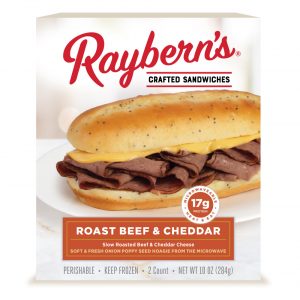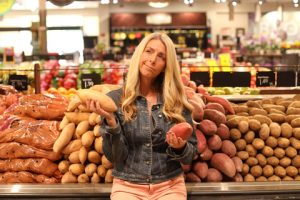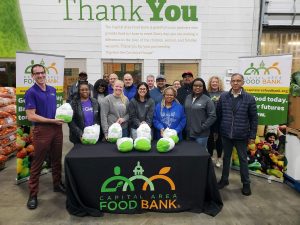Raybern’s Rebrands Packaging, Revamping Deli Sandwich Line
 Raybern’s, a brand known for offering authentic deli-style Philly Cheesesteak sandwiches, kicks off a rebrand not only in package design, but in terms of quality, quantity and variety of sandwich ingredients. Beginning Q1, 2024, Raybern’s will introduce a revamp of its entire line, offering unique flavors and formats that are designed and created to thrill discerning sandwich lovers everywhere.
Raybern’s, a brand known for offering authentic deli-style Philly Cheesesteak sandwiches, kicks off a rebrand not only in package design, but in terms of quality, quantity and variety of sandwich ingredients. Beginning Q1, 2024, Raybern’s will introduce a revamp of its entire line, offering unique flavors and formats that are designed and created to thrill discerning sandwich lovers everywhere.
Five delicious Raybern’s varieties will be available in 2-ct packs to consumers at an SRP of $5.79, and sold in freezer cases everywhere.
Raybern’s introduces new and innovative recipes to their full line of mouthwateringly savory sandwiches. Notably, the Roast Beef & Cheddar sandwich is now complemented with a soft, poppy seed roll. In addition, Raybern’s is relaunching their Ham & Cheese sandwich, enhanced by a sweet deli roll.
The rest of the line has been upgraded with delectable meats, cheeses and sauces, including the Philly Cheesesteak, Chicken Bacon Ranch and Barbecue Pulled Pork. In this complete brand overhaul, Raybern’s is ensuring that frozen food consumers don’t have to compromise when they walk down the freezer aisle.
“Our new sandwich line up is a totally delicious innovation on sandwiches of the past,” shares Doug Hall, director of marketing at Raybern’s. “We have the bakery-soft bun covered, but we’ve completely amped up the meats, cheeses and sauces on our favorite frozen deli-style sandwiches! My personal favorite is the Roast Beef & Cheddar now on a fresh poppy seed roll.”
When it comes to sandwiches, Raybern’s has proven to be a brand that knows how to bring amazing flavor from the freezer to the microwave. Over 30 years ago, the founders Ray and Bernie envisioned sharing their love of New York-style deli sandwiches with the world. It took years to fully develop the Raybern’s bread recipe that cooks up “Bakery Soft” right from the microwave – as well as their signature Philly Cheesesteak recipe.
Today, Raybern’s is proud to make millions of sandwiches each year, including the best-selling Philly Cheesesteak in America, according to 2023 Nielsen Scan Data. Now, the brand introduces bigger and better sandwiches to continue giving consumers what they crave.
Raybern’s believes that the New York-style deli sandwich reigns supreme. Since 1978, they have been crafting incredibly delicious sandwiches with bakery-soft bread, slow-roasted meats and chef-created sauces. Now, consumers can enjoy authentic deli goodness at home or while on-the-go. It is Raybern’s mission to share its love of great sandwiches with as many people as possible and ensure that sandwich lovers don’t need to compromise in the freezer aisle.
For more new products in the specialty food industry, subscribe to Gourmet News.
Giant Food, Shady Brook Farms Donate 11K Turkeys to Food Banks
Giant Food, the leading greater Washington, D.C. regional grocery chain, has announced its annual holiday turkey donations. In partnership with Shady Brook Farms, Giant Food will be donating 11,000 turkeys to its local Feeding America food banks partners as well as local organizations including Martha’s Table, Men Aiming Higher, THEARC: Building Bridges Across The River, Greater Washington Urban League and Greater Baltimore Urban League. Since 2011, Giant has donated 62,000 turkeys during Thanksgiving and this year, Shady Brook Farms is generously providing additional turkeys to make an even larger impact.
“At Giant, fighting food insecurity in the communities we serve is one of our top priorities,” said Dyani Hanrahan, vice president of marketing and community relations, Giant Food, and Maryland Food Bank board member. “We are proud to support over 20 community organizations this Thanksgiving in partnership with Shady Brook Farms to make sure our neighbors in need enjoy their holiday celebrations with family and loved ones.”
“At Shady Brook Farms, we take great responsibility in not only giving back during the critical holiday season, but also throughout the year to ensure families and local communities have access to delicious and nutritious meals,” said Hannah Kern, Shady Brook Farms marketing manager. “Partnering with a like-minded organization such as Giant Food to provide turkeys to those in need is incredibly meaningful and we’re beyond appreciative of their collaboration on impactful initiatives such as this.”
Additionally, Giant launched the annual “Lend a Hand for Hunger” campaign to benefit five area Feeding America food banks – Capital Area Food Bank, Maryland Food Bank, Food Bank of Delaware, Fredericksburg Regional Food Bank and Blue Ridge Area Food Bank – and other area nonprofits.
The campaign, running from Oct. 27 to Dec. 31 in all 164 Giant stores, offers customers an opportunity to support their neighbors by rounding up their change to the nearest dollar amount during checkout in-store or selecting a donation of $1, $3 or $5 during checkout in-store or online. Last year, through the generous support of associates and customers, over $1 million was raised to fight food insecurity.
For news of interest to the grocery industry, subscribe to Gourmet News.
Yam or Sweetpotato? Sweetpotato or Sweet Potato? Answers Here
 It happens every Thanksgiving. You head to the grocery store to shop for the big day. Of course, you’ll need to buy yams for the family’s favorite casserole. But when you get to the produce department, the display sign says “sweetpotato.” Or perhaps some are labeled as “yams” and others are “sweetpotatoes.” Which should you buy? And what’s the difference between a sweetpotato and a yam anyway?
It happens every Thanksgiving. You head to the grocery store to shop for the big day. Of course, you’ll need to buy yams for the family’s favorite casserole. But when you get to the produce department, the display sign says “sweetpotato.” Or perhaps some are labeled as “yams” and others are “sweetpotatoes.” Which should you buy? And what’s the difference between a sweetpotato and a yam anyway?
This Thanksgiving, California sweetpotato farmers are on a mission to end this confusion once and for all. Their message is really very simple: Yam = Sweetpotato
“Sweetpotatoes come in all kinds of colors – red, orange, white, and, even purple. You may see them labeled as yams in the grocery store, but they’re actually sweetpotatoes,” explains Sarah Alvernaz, who farms sweetpotatoes in the heart of California’s sweetpotato growing region.
Alvernaz and other California growers who make up the California Sweetpotato Council are working to educate consumers and put an end to all the confusion about sweetpotatoes versus yams, particularly for younger consumers who may not be interested in eating yams but have heard that sweetpotatoes are a superfood.
“True yams are very different from sweetpotatoes and are a starchy, tuberous vegetable mostly grown in Africa,” explains Alvernaz. “You are unlikely to find true yams at a U.S. supermarket, despite what you might see on display signs.”
Unlike yams, sweetpotatoes are native to the Americas. The United States produces approximately 1.7 million tons of sweetpotatoes each year. California is the second largest producing state for sweetpotatoes because the warm dry climate and sandy soils of California’s Central Valley provide the optimum growing environment for quality roots. Some 90 percent of California’s sweetpotatoes are grown within a 20-mile radius of the small town of Livingston and the remaining 10 percent are grown near Bakersfield.
Alvernaz also explains that it’s common to see some sweetpotatoes at your grocery store labeled by varietal names such as Covington, Garnet or Jewell. But growers actually produce dozens of different varieties.
“We’re encouraging retailers to label sweetpotatoes according to color,” notes Alvernaz. “Most varieties we grow can be accurately categorized as either red, orange, white or purple sweetpotatoes. All four types have similar cooking times and can be used pretty much interchangeably in recipes.”
“We just want people to know that sweetpotato is a modern, more accurate term than yam,” says Alvernaz. “Even if they’re labeled as yams in the store, they are sweetpotatoes! Whether they’re red, orange, white or purple – all can be used in any recipe that calls for yams. Sweetpotatoes are a versatile, delicious superfood available every day of the year.”
To help support this message, the California Sweetpotato Council is working with retailers to correctly label sweetpotatoes in their stores. Shoppers can find simplified, updated information about sweetpotatoes here.
“Rest assured the Thanksgiving yam dish that’s been in your family for generations has always been made with sweetpotatoes,” says Alvernaz. “Probably with red or orange varieties but go ahead and buy whatever color you find in your store. And don’t forget that sweetpotatoes can be used in a variety of recipes not just for the holidays.”
Alvernaz adds that sweetpotatoes are, in fact, a superfood with each containing over 80 nutrients. They’re high in vitamin B6, vitamin A, carotene, and potassium, they’re rich in antioxidant vitamins C and E and are a great source of manganese and dietary fiber.
More information about sweetpotato nutrition, cooking facts and delicious recipes can be found at the California Sweetpotato Council website here.
For the record, the council says it’s sweetpotato, not sweet potato: On this one we admit there’s not a lot of agreement. But we believe that “sweetpotato” is correct because our product is not, in fact, a sweet potato. It’s not a potato at all, but botanically an entirely different vegetable, gifted with a totally different set of better-for-you nutrients, amazing taste, and incredible versatility. So sweetpotatoes—one word—is not only grammatically correct, but it helps make the distinction.
For more news of interest to the specialty food industry, subscribe to Gourmet News.
